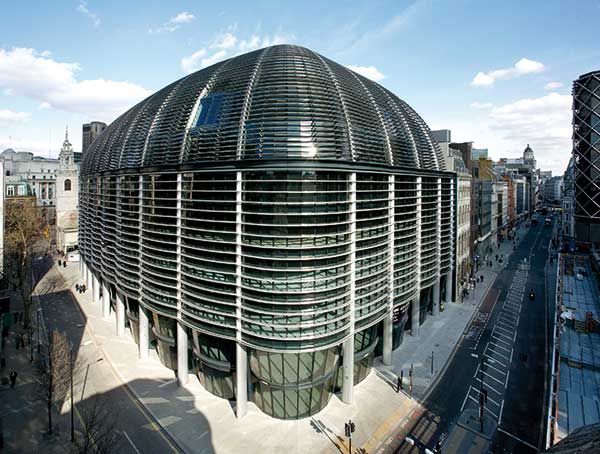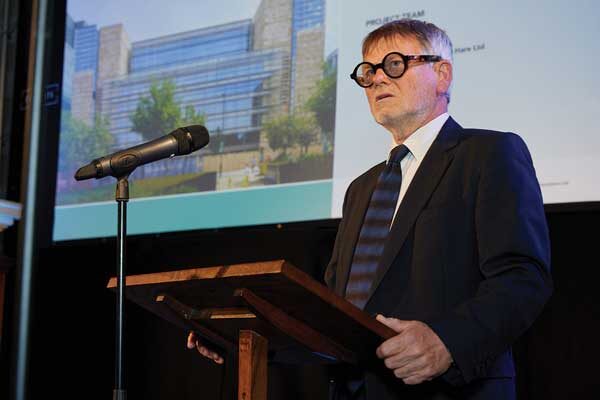Projects and Features
SSDA 2018: Introduction and Judges
 Introduction
Introduction
By Christopher Nash RIBA – Chairman of the Judging panel.
This year, as new chairman of the panel, I am very pleased to see a judging team rejuvenated by the introduction of Julia Ratcliffe and Sarah Pellereau from engineering design consultancies and of Paul Hulme from the steel fabrication industry. The panel is sharpened by the introduction of this new talent. I think I can speak for all members of the panel when I say that we always bring enthusiasm and enjoyment to the job, as well as fair-minded dispassionate judgement, and this year has been no exception.
Again there has been a pleasing increase in the overall number of entries to the scheme.
Scales of entry range from the largest civil engineering and transport projects, through prestige city office buildings, to smaller community and public buildings and sculptures. While there are fewer residential projects this year, we see an increase in office buildings of high quality and a welcome return of top end industrial building.
As in previous years a preliminary selection was made on the basis of a close examination of the entry documents. The resultant shortlist of schemes were all then notified and each visited by at least two judges from different disciplines.
At this point I’d like to pass my thanks to the hosting teams who went out of their way to be present to answer the judges detailed questions. Unlike some other award schemes, we believe it is essential to get down close and personal with the entered projects before making our final assessments. The project teams’ demonstration of collaboration always comes through and is a major part in our assessment of the entry.
There are jaw-dropping achievements here, and beautiful gems. I believe everyone involved in the steel construction industry should be proud of what has been achieved, and I trust that the Structural Steel Design Awards reflect the quality of the achievement.
The Judges
 Christopher Nash is a senior Consultant Architect. He graduated in 1978 from Bristol University School of Architecture, and was at Grimshaw Architects from 1982, becoming a Director from 1992, Managing Partner from 1998 to 2008, and retiring from the Partnership in 2012. While at Grimshaw he was responsible for many of the practice’s high profile buildings. These include – from his early years – the Financial Times Printing Works in London’s Docklands and the British Pavilion for the Seville Expo 92, The Western Morning News headquarters in Plymouth, the RAC Regional Headquarters in Bristol and many other projects. Following the success of the Zurich Airport fifth expansion project, he returned to a smaller scale of work with the Cutty Sark Conservation Project. Chris continues to practise as a consultant in architectural practice management, architectural education and property development.
Christopher Nash is a senior Consultant Architect. He graduated in 1978 from Bristol University School of Architecture, and was at Grimshaw Architects from 1982, becoming a Director from 1992, Managing Partner from 1998 to 2008, and retiring from the Partnership in 2012. While at Grimshaw he was responsible for many of the practice’s high profile buildings. These include – from his early years – the Financial Times Printing Works in London’s Docklands and the British Pavilion for the Seville Expo 92, The Western Morning News headquarters in Plymouth, the RAC Regional Headquarters in Bristol and many other projects. Following the success of the Zurich Airport fifth expansion project, he returned to a smaller scale of work with the Cutty Sark Conservation Project. Chris continues to practise as a consultant in architectural practice management, architectural education and property development.
 Richard Barrett was Managing Director of Barrett Steel Buildings for over 20 years prior to its sale in 2007 in a management buyout, and is a Director of steel stockholder Barrett Steel. Richard studied engineering at Cambridge University, graduating in 1978. At Barrett Steel Buildings, he developed the business into a leading specialist in the design and build of steel framed buildings for structures such as distribution warehouses, retail parks, schools, offices and hospitals. He was President of the BCSA from 2007 to 2009, and was a member of BCSA’s Council from 1994 to 2017.
Richard Barrett was Managing Director of Barrett Steel Buildings for over 20 years prior to its sale in 2007 in a management buyout, and is a Director of steel stockholder Barrett Steel. Richard studied engineering at Cambridge University, graduating in 1978. At Barrett Steel Buildings, he developed the business into a leading specialist in the design and build of steel framed buildings for structures such as distribution warehouses, retail parks, schools, offices and hospitals. He was President of the BCSA from 2007 to 2009, and was a member of BCSA’s Council from 1994 to 2017.
 Paul Hulme joined Robert Watson & Co as an apprentice draughtsman in 1981. In the following 36 years he held positions in all areas of the company, gaining appreciation of all aspects of the steelwork industry, most recently in the role of Project Director. Over the years Paul has been fortunate to be involved in many complex steel structures, both in UK and abroad. Most notable are Kansai and Hong Kong airports, Terminal 5 roof, London 2012 Olympic Stadium and Wimbledon Centre Court Redevelopment. Paul currently works as an independent consultant offering design and buildability advice to the construction industry. Paul is a Fellow of the Institution of Civil Engineering.
Paul Hulme joined Robert Watson & Co as an apprentice draughtsman in 1981. In the following 36 years he held positions in all areas of the company, gaining appreciation of all aspects of the steelwork industry, most recently in the role of Project Director. Over the years Paul has been fortunate to be involved in many complex steel structures, both in UK and abroad. Most notable are Kansai and Hong Kong airports, Terminal 5 roof, London 2012 Olympic Stadium and Wimbledon Centre Court Redevelopment. Paul currently works as an independent consultant offering design and buildability advice to the construction industry. Paul is a Fellow of the Institution of Civil Engineering.
 Sarah Pellereau is an Associate at Price & Myers with 17 years’ experience. She has been involved in a number of award winning schemes including leading a project shortlisted for the Stirling prize. As a structural engineer she is rare in having graduated with a Part 1 in Architecture as well as a Masters in Engineering from the University of Leeds. She has a diverse portfolio of experiences in structural design but also has worked on-site with the CTRL alterations to St Pancras Station and tutored at Nottingham University.
Sarah Pellereau is an Associate at Price & Myers with 17 years’ experience. She has been involved in a number of award winning schemes including leading a project shortlisted for the Stirling prize. As a structural engineer she is rare in having graduated with a Part 1 in Architecture as well as a Masters in Engineering from the University of Leeds. She has a diverse portfolio of experiences in structural design but also has worked on-site with the CTRL alterations to St Pancras Station and tutored at Nottingham University.
 Roger Plank is a structural engineer and, having recently retired as Professor of Architecture and Structural Engineering at the University of Sheffield, is currently a director of Vulcan Solutions Ltd offering software and consultancy services in fire engineering. He has collaborated extensively with the steel construction sector in the fields of fire engineering and sustainability, and is a Past President of the Institution of Structural Engineers.
Roger Plank is a structural engineer and, having recently retired as Professor of Architecture and Structural Engineering at the University of Sheffield, is currently a director of Vulcan Solutions Ltd offering software and consultancy services in fire engineering. He has collaborated extensively with the steel construction sector in the fields of fire engineering and sustainability, and is a Past President of the Institution of Structural Engineers.

Julia Ratcliffe is an independent structural engineering consultant with 25 years’ experience in structural engineering design. She has collaborated with leading architects and designers both in the UK and internationally on buildings ranging from towers and performing arts centres to private residences. Until recently, she has been with Expedition Engineering which she joined in 2006, becoming a Director in 2011. Previously, she worked with BuroHappold in the UK and USA. She is a CABE Built Environment expert and has served as a judge for the Institution of Structural Engineers and RIBA London awards.
 Bill Taylor is an architect in private practice. He joined architects Michael and Patty Hopkins straight from the Sheffield School of Architecture in 1982 and in 1988 became their partner. He was a pivotal figure in the development and success of the practice in the UK and overseas and was responsible for a large number of award winning projects, many of which received a Structural Steel Design Award. Bill left Hopkins Architects in Spring 2010 to concentrate on his own projects. In 2011, together with Robin Snell, they formed Robin Snell and Partners and continue in practice from their London studio. He has been a member of the RIBA National Awards Group, is a Senior Assessor for the RIBA Competitions programme and was a founding member of Tensinet, the pan-European organisation that researches lightweight structures and membrane architecture.
Bill Taylor is an architect in private practice. He joined architects Michael and Patty Hopkins straight from the Sheffield School of Architecture in 1982 and in 1988 became their partner. He was a pivotal figure in the development and success of the practice in the UK and overseas and was responsible for a large number of award winning projects, many of which received a Structural Steel Design Award. Bill left Hopkins Architects in Spring 2010 to concentrate on his own projects. In 2011, together with Robin Snell, they formed Robin Snell and Partners and continue in practice from their London studio. He has been a member of the RIBA National Awards Group, is a Senior Assessor for the RIBA Competitions programme and was a founding member of Tensinet, the pan-European organisation that researches lightweight structures and membrane architecture.
 Oliver Tyler joined Wilkinson Eyre Architects (WEA) in 1991 becoming a Director in 1999. He has spent over 25 years in architectural practice and has extensive experience in leading and coordinating the design and construction of many high profile buildings and infrastructure projects. Oliver has led a number of prestigious projects at WEA including Stratford Regional Station in London for the Jubilee Line Extension; the Dyson Headquarters in Wiltshire, regional headquarters for Audi in west London, the Arena and Convention Centre in Liverpool, the UK’s first urban cable car, the Emirates Air Line and most recently a new office building in Finsbury Circus. Oliver is currently leading a number of major infrastructure and commercial office schemes in the City of London, including Liverpool Street Station for Crossrail, the Bank Station capacity upgrade project and a 50-storey office tower on Leadenhall Street.
Oliver Tyler joined Wilkinson Eyre Architects (WEA) in 1991 becoming a Director in 1999. He has spent over 25 years in architectural practice and has extensive experience in leading and coordinating the design and construction of many high profile buildings and infrastructure projects. Oliver has led a number of prestigious projects at WEA including Stratford Regional Station in London for the Jubilee Line Extension; the Dyson Headquarters in Wiltshire, regional headquarters for Audi in west London, the Arena and Convention Centre in Liverpool, the UK’s first urban cable car, the Emirates Air Line and most recently a new office building in Finsbury Circus. Oliver is currently leading a number of major infrastructure and commercial office schemes in the City of London, including Liverpool Street Station for Crossrail, the Bank Station capacity upgrade project and a 50-storey office tower on Leadenhall Street.













